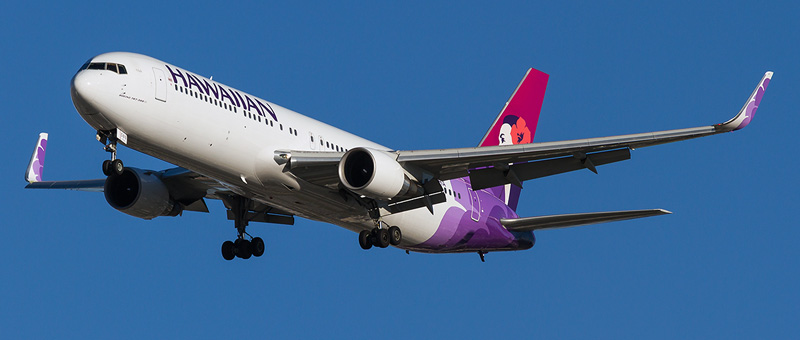
Seat map Boeing 767-300 “Hawaiian Airlines”. Best seats in the plane
Hawaiian Airlines operates 2 versions of Boeing 767-300.
First cabin version of the Boeing 767-300ER (763) V1
First version of Boeing 767-300 is the most common in the Hawaiian Airlines fleet. This airplane may transport 252 passengers in two classes: first and economy.
First class consists of 3 rows of seats that have 2-2-2 configuration. All these seats are standard. Passengers of the seats of the first row will take advantage of extra legroom. Among disadvantages of these seats: lack of floor storage during take-off and landing and close location of the lavatory and galley.
234 seats of the economy class are divided into three sections. First section consists of 6 rows of seats. 5 of them have 2-3-2 configuration and one row with 2 seats. The seats of the rows 11-16 have a little less space for passengers legs than other standard seats of the economy class. Also, the seats of the 11th row are narrower as the tray tables are in the armrests making them immovable and have no floor storage during take-off and landing.
The seats of the 16th row are less reclining or not reclining at all. In addition these seats are located close to the galley the noise from which may cause discomfort. Due to entertainment equipment stored under these seats the legroom is limited.
Behind the exit row the second section of Economy class seats is located. Most of them have 2-3-2 configuration.
Limited legroom, limited recline, proximity of the lavatories and galley as well as reduced width and lack of floor storage during take-off and landing make the seats 16CEG bad seats.
The main disadvantages of the seats 17AB and 17HJ are: restricted legroom, close location of the lavatories, reduced width and lack of floor storage during take-off and landing.
The seats 19A and 19J have no windows.
Because of the exit row located behind the seats of the 31st row have limited or no recline. It may get cold by the exits on the seats 31A and 31J. The legroom of the seats 31B, 31C and 31H is reduced because of the entertainment equipment stored under these seats.
Behind another exit row the third section of economy class seats is located.
All B,C and H seats of this section have restricted legroom and storage space because of the entertainment equipment stored under these seats.
The best seats here are the seats 32CEG, 32B and 32H as these seats offer extra legroom. But these seats have no floor storage during take-off and landing and are narrower than standard as the tray tables are built-in the armrests of these seats making them immovable.
The seats 32A and 32J have the same advantage as extra legroom and the same disadvantages as the seats 32CEG, 32B and 32H and in addition as the exit door protrudes inside passengers of these seats have to angle their legs to stretch them out.
Close location of the lavatories will cause discomfort to passengers of the seats 43C and 43G.
Other passengers tend to congregate in the area of the seats 43AB, 43HJ and 44CEG while waiting to use lavatories. Also these seats have limited recline that makes these seats bad seats.
Second cabin version of the Boeing 767-300ER (763) V2
The second version of Boeing 767-300 operated by Hawaiian Airlines is operated on long-haul routes.
This airplane may accommodate 259 passengers in two classes: first and economy.
First class has 18 reclining seats located in 3 rows per 6 in each. All of them are standard. Only the seats of the 1st row have some peculiarities. Passengers of these seats will take advantage of extra legroom. Among disadvantages: lack of floor storage during take-off and landing and close location of the galleys and lavatory.
241 passengers may transport economy class. The seats of the economy class are located in three sections. First section consists of 13 rows of seats that have 2-3-2 configuration. Because of the bulkhead position the seats of the 11th row have less legroom.
The seats 21A and 21J have no windows.
The only disadvantage of the seats of the 23rd row is proximity of the galleys and lavatories.
Behind the galleys, lavatories and exit rows the second section of economy class seats is located. This sections contains 6 rows of seats per 7 in each. Thanks to the exit row located in front the seats of the 26th row offer extra legroom. Other passengers tend to congregate in the area of these seats while waiting to use lavatories.
Due to the exit row located behind the seats of the 31st row are less reclining than standard.
Behind another exit row the third section of economy class seats is located. The seats of the 32nd row are considered the best seats on the airplane. These seats have extra space for passengers’ legs. However, these seats are narrower than standard as the tray tables are in the armrests making them immovable and have no floor storage during take-off and landing.
The main disadvantage of the seats 46C and 46G is proximity of the lavatories.
Limited recline and close location of the lavatories make the seats 46AB, 46HJ and 47CEG bad seats.
Usefull information about “Hawaiian Airlines”
- Rating and reviews about “Hawaiian Airlines”
- Boeing 767-300 Hawaiian Airlines. Photos and description of the plane
- Hawaiian Airlines – company description and aircrafts fleet


